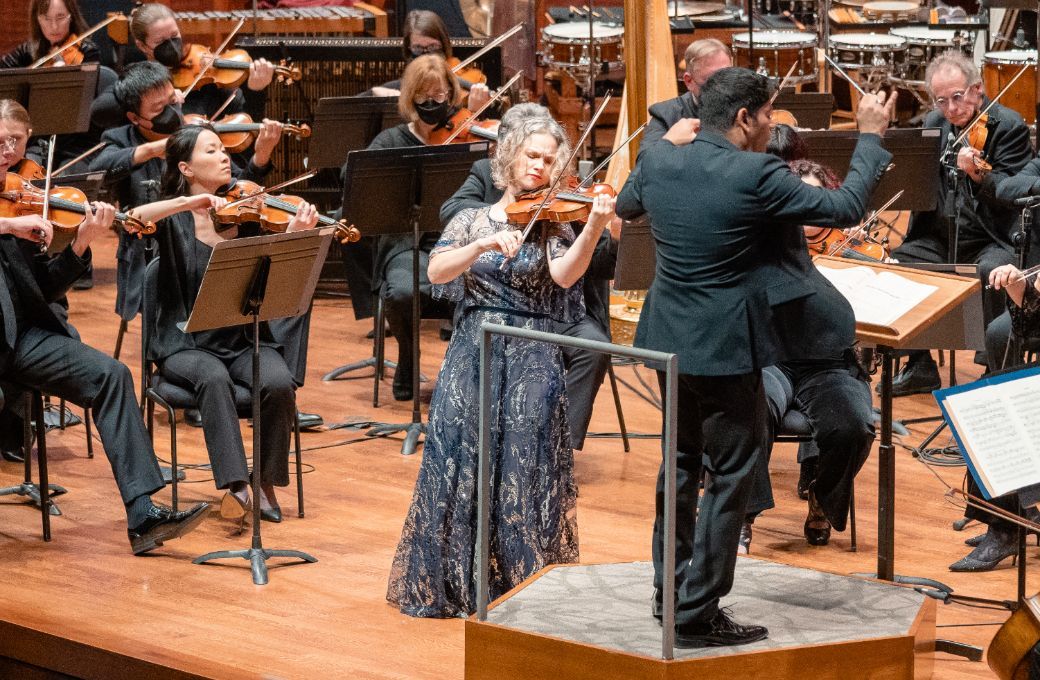Wariness about attending live performance persists. So it was heartening to be reminded of the time before the pandemic, when an artist of Hilary Hahn’s caliber could easily draw a crowd. But if the violinist restored a sense of continuity with familiar, and essential, musical values, the audience that packed Benaroya Hall for her return engagement with Seattle Symphony also had a wonderful surprise in store. It’s safe to say that Alpesh Chauhan, making his SSO debut at the podium, was a new discovery for most of those present. He led a program of Brahms and Lutosławski that remained gripping throughout and, at times, revelatory.
The young British conductor not only showed a fluent command of this repertoire but conveyed a sense of conviction in the performances he inspired from the SSO. Based in his native Birmingham and a rapidly rising star in Europe, the 32-year-old Chauhan has yet to become known in the US, but I suspect this will change as word of his remarkable talent spreads.
A deep affinity with Brahms was evident from the first, slashing chords of the Tragic Overture. Chauhan understood the piece to be no mere concert opener but a symphony in miniature. Brahms disavowed any programmatic interpretation (despite attempts to link this music to a planned production of Goethe’s Faust), but Chauhan shaped a compelling narrative trajectory in purely sonic terms, eliciting subtle but dramatically telling shifts in textural weight and color. He made sense of Brahms’ unusual formal alterations with his staging of the inexorable return to the tragic mode.
To judge by the musicians’ responsiveness and rapt involvement throughout the evening, Chauhan was able to establish a rapport with the SSO that made it sound as if they had been performing together for some time. In Brahms’ Violin Concerto in D major, the collaboration with Hilary Hahn was a genuine partnership, conductor and soloist sharing a tendency to emphasize the sweeping grandeur and spaciousness of the first movement in particular. Hahn never tires of finding something new and important to say with this music, no matter how often she has performed it.

Her account, lingering meaningfully over phrasings and showing a sovereign consistency of tone, combined vividly dramatic declamations with profound introspection and ecstatic lyricism. Hahn revealed all of these threads as more than mere contrasts — components of a singular, complex personality. Even more, she brought out a sense of loss, an undertow of vulnerability, in such moments as the bittersweet transition from the cadenza when the orchestra rejoined her in the final pages of the first movement. Instead of a light bonbon, as her encore Hahn offered the Sarabande from Bach’s D minor Partita. Phrased with unforced, humane gravitas, it posited an intriguing postlude to the Brahms.
Chauhan made space for Hahn as needed in the concerto, expertly adjusting balances to keep her voice in the forefront while at the same time drawing attention to beguiling timbral blends with the orchestra. Kudos to Mary Lynch VanderKolk’s heartrending oboe lines. I’d have preferred a tad more tempo flexibility in the first movement, but the rhythmic spring of the finale had wit and a leavening sense of fun. And in the program’s second half, the SSO and Chauhan seemed especially to enjoy the invention and kaleidoscopic variety of texture in Lutosławski’s Concerto for Orchestra. With balletic hand motions and energetic podium leaping, Chauhan reveled in the score’s contrasts between feather-light, misterioso whisperings and aggressive tutti driven by the brass. The rapturous applause that erupted prompted the conductor to single out every section of the orchestra for praise before taking his own bow.


